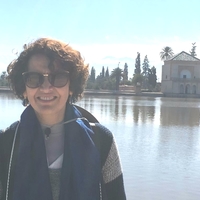Papers by Letizia Scuderi
For the solution of 2D exterior Dirichlet Poisson problems we propose the coupling of a Curved Vi... more For the solution of 2D exterior Dirichlet Poisson problems we propose the coupling of a Curved Virtual Element Method (CVEM) with a Boundary Element Method (BEM), by using decoupled approximation orders. We provide optimal convergence error estimates, in the energy and in the weaker $\textit{L}^\text{2}$-norm, in which the CVEM and BEM contributions to the error are separated. This allows taking advantage of the high order flexibility of the CVEM to retrieve an accurate discrete solution by using a low order BEM. The numerical results confirm the a priori estimates and show the effectiveness of the proposed approach.
Computers & Mathematics with Applications, 2021
Research has shown a strong negative correlation between birth order and cognitive test scores, I... more Research has shown a strong negative correlation between birth order and cognitive test scores, IQ, and educational outcomes. We ask whether birth order differences in health are present at birth using matched administrative data for more than 1,000,000 children born in Denmark between 1981 and 2010. Using family fixed effects models, we find a positive and robust birth order effect; lower parity children are less healthy at birth. Looking at the potential mechanisms, we find that during earlier pregnancies women have higher labor market attachment, behave more risky in terms of smoking, receive more prenatal care,
We consider the Helmholtz equation defined in unbounded domains, external to 2D bounded ones, end... more We consider the Helmholtz equation defined in unbounded domains, external to 2D bounded ones, endowed with a Dirichlet condition on the boundary and the Sommerfeld radiation condition at infinity. To solve it, we reduce the infinite region, in which the solution is defined, to a bounded computational one, delimited by a curved smooth artificial boundary and we impose on this latter a non reflecting condition of boundary integral type. Then, we apply the curved virtual element method in the finite computational domain, combined with the one-equation boundary element method on the artificial boundary. We present the theoretical analysis of the proposed approach and we provide an optimal convergence error estimate in the energy norm. The numerical tests confirm the theoretical results and show the effectiveness of the new proposed approach.

Mathematics and Computers in Simulation, 2021
Abstract Cell migration is fundamental in a wide variety of physiological and pathological phenom... more Abstract Cell migration is fundamental in a wide variety of physiological and pathological phenomena, being exploited in biomedical engineering as well. In this respect, we here present a hybrid non-local integro-differential model where a representative cell, reproduced by a point particle with an orientation, moves on a planar domain upon signals coming from environmental variables. From a numerical point of view, non-locality implies the need to evaluate integral terms which may present non-regular integrand functions because of heterogeneities in the environmental conditions and/or in cell sensing region. Having in mind multicellular applications, we here propose a robust computational method able to handle such non-regularities. The procedure is based on low order Runge–Kutta methods and on an ad hoc application of the Gauss–Legendre quadrature rule. The accuracy and efficiency of the resulting computational method is then tested by selected benchmark settings. In this context, the ad hoc application of the quadrature rule reveals to be crucial to obtain a high accuracy with a remarkably low number of quadrature nodes with respect to the standard Gauss–Legendre quadrature formula, and which thus results in a reduced overall computational cost. Finally, the proposed method is further coupled with the cubic spline interpolation scheme which allows to deal also with possible poor (i.e., point-wise defined) molecular spatial information. The performed simulations (which accounts also for different scenarios) show how the interpolation of the molecular variables affects the efficiency of the overall method and further justify the proposed procedure.

Applied Mathematics and Computation, 2020
We consider a wave propagation problem in 2D, reformulated in terms of a Boundary Integral Equati... more We consider a wave propagation problem in 2D, reformulated in terms of a Boundary Integral Equation (BIE) in the space-time domain. For its solution, we propose a numerical scheme which is based on a second order Lubich discrete convolution quadrature formula for the discretization in time, coupled with a classical Galerkin method in space. It is known that the main advantage of the Lubich formula is the use of the FFT algorithm to retrieve the discretization in time of the integral operators with a computational complexity of order R log R, R being twice the total number of time steps performed. On the other hand, the discretization in space leads in general to a quadratic complexity, hence the global working storage required is M 2 R/2, where M is the number of grid points chosen on the domain boundary. To reduce the complexity in space, we consider here approximant functions of wavelet type. According to the properties of the wavelet basis, it turns out that the discretized integral operators have a rapid decay to zero with respect to the time, and the overwhelming majority of the associated matrix entries assume negligible values. Based on an a priori estimate of the decaying behavior in time of the matrix entries, we devise a time downsampling strategy that allows to compute only the elements which are significant with respect to a prescribed tolerance. Such approach allows to obtain highly sparse matrices by a downsampled FFT algorithm with a computational complexity of order R log R, where R R.
Applied Numerical Mathematics, 2018
On the discretization and application of two space-time boundary integral equations for 3D wave p... more On the discretization and application of two space-time boundary integral equations for 3D wave propagation problems in unbounded domains / Falletta, Silvia; Monegato, Giovanni; Scuderi, Letizia.-In: APPLIED NUMERICAL MATHEMATICS.
Computers & Mathematics with Applications, 2019
We consider (transient) 3D elastic wave propagation problems in unbounded isotropic homogeneous m... more We consider (transient) 3D elastic wave propagation problems in unbounded isotropic homogeneous media, which can be reduced to corresponding 2D ones. For their solution, we propose and compare two boundary integral equation approaches, both based on the coupling of a discrete time convolution quadrature with a classical space collocation discretization. In the first approach, the PDE problem is preliminary replaced by the equivalent well known (vector) space-time boundary integral equation formulation, while in the second, the same PDE is replaced by a system of two (coupled) wave equations, each one of which is then represented by the associated boundary integral equation. The construction of these two approaches is described and discussed. Some numerical testing are also presented.
SIAM Journal on Numerical Analysis, 1998
We are concerned with the numerical solution of the generalized airfoil equation for an airfoil w... more We are concerned with the numerical solution of the generalized airfoil equation for an airfoil with a flap by means of global algebraic polynomial approximants. This problem has been considered in a recent paper by Monegato and Sloan [SIAM J. Numer. Anal., 34 (1997), pp. 2288--2305], where the authors proved the stability and convergence of a Galerkin method based on high order polynomials. They also presented very promising numerical results for the corresponding collocation method but left the theoretical results of stability and convergence as an open problem. We have succeeded in proving the stability and convergence properties of this collocation method by slightly modifying it in the neighborhood of the flap. The rate of convergence we have derived for our collocation method is very similar to that of the above Galerkin method.
Indian Journal of Mathematics
Applied Numerical Mathematics, 2015
We consider the retarded potential boundary integral equation, arising from the 3D Dirichlet exte... more We consider the retarded potential boundary integral equation, arising from the 3D Dirichlet exterior wave equation problem. For its numerical solution we use compactly supported temporal basis functions in time and a standard collocation method in space. Since the accurate computation of the integrals involved in the numerical scheme is a key issue for the numerical stability, we propose a new efficient and competitive quadrature strategy. We compare this approach with the one that uses the Lubich time convolution quadrature, and show pros and cons of both methods.
Applied Mathematics and Computation, 2015
In this paper we consider the 2D exterior problem for the non homogeneous wave equation, with mix... more In this paper we consider the 2D exterior problem for the non homogeneous wave equation, with mixed type boundary conditions and non homogeneous initial conditions, these latter having local supports. First we derive a space-time boundary integral equation formulation to solve the problem. Then we propose a numerical approach for its solution, which couples a Lubich discrete convolution quadrature with a classical collocation method. For the computation of the extra "volume" integrals generated by the initial data, having local supports, we propose a new numerical approach. Finally, we solve some test problems and present some of the numerical results we have obtained.
Springer Optimization and Its Applications, 2010
Several quadrature rules for the numerical integration of smooth (non-oscillatory) functions, def... more Several quadrature rules for the numerical integration of smooth (non-oscillatory) functions, defined on the real (positive) semiaxis or on the real axis and decaying algebraically at infinity, are examined. Among those considered for the real axis, four alternative numerical approaches are new. The advantages and the drawbacks of each of them have been pointed out through several numerical tests, either on the computation of a single integral or on the numerical solution of some integral equations.






Uploads
Papers by Letizia Scuderi